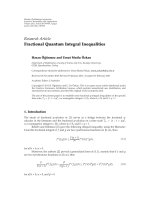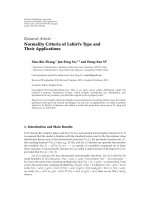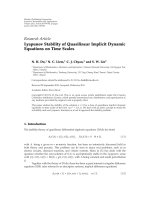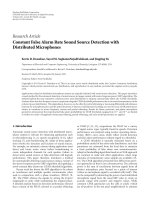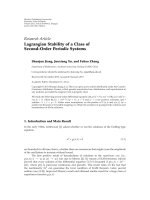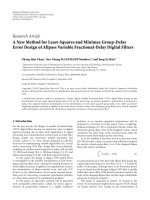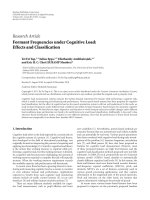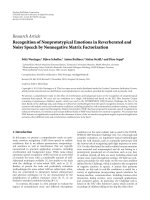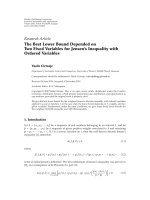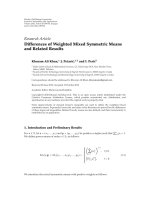Báo cáo hóa học: " Research Article Topological Vector Space-Valued Cone Metric Spaces and Fixed Point Theorems" doc
Bạn đang xem bản rút gọn của tài liệu. Xem và tải ngay bản đầy đủ của tài liệu tại đây (539.29 KB, 17 trang )
Hindawi Publishing Corporation
Fixed Point Theory and Applications
Volume 2010, Article ID 170253, 17 pages
doi:10.1155/2010/170253
Research Article
Topological Vector Space-Valued Cone Metric
Spaces and Fixed Point Theorems
Zoran Kadelburg,
1
Stojan Radenovi
´
c,
2
and Vladimir Rako
ˇ
cevi
´
c
3
1
Faculty of Mathematics, University of Belgrade, Studentski trg 16, 11000 Beograd, Serbia
2
Faculty of Mechanical Engineering, University of Belgrade, Kraljice Marije 16, 11120 Beograd, Serbia
3
Department of Mathematics, Faculty of Sciences and Mathematics, University of Ni
ˇ
s, Vi
ˇ
segradska 33,
18000 Ni
ˇ
s, Serbia
Correspondence should be addressed to Stojan Radenovi
´
c,
Received 18 December 2009; Revised 14 July 2010; Accepted 19 July 2010
Academic Editor: Hichem Ben-El-Mechaiekh
Copyright q 2010 Zoran Kadelburg et al. This is an open access article distributed under the
Creative Commons Attribution License, which permits unrestricted use, distribution, and
reproduction in any medium, provided the original work is properly cited.
We develop the theory of topological vector space valued cone metric spaces with nonnormal
cones. We prove three general fixed point results in these spaces and deduce as corollaries several
extensions of theorems about fixed points and common fixed points, known from the theory
of normed-valued cone metric spaces. Examples are given to distinguish our results from the
known ones.
1. Introduction
Ordered normed spaces and cones have applications in applied mathematics, for instance, in
using Newton’s approximation method 1–4 and in optimization theory 5. K-metric and
K-normed spaces were introduced in the mid-20th century 2,seealso3, 4, 6 by using
an ordered Banach space instead of the set of real numbers, as the codomain for a metric.
Huang and Zhang 7 reintroduced such spaces under the name of cone metric spaces but
went further, defining convergent and Cauchy sequences in the terms of interior points of
the underlying cone. These and other authors see, e.g., 8–22 proved some fixed point and
common fixed point theorems for contractive-type mappings in cone metric spaces and cone
uniform spaces.
In some of the mentioned papers, results were obtained under additional assumptions
about the underlying cone, such as normality or even regularity. In the papers 23, 24,the
authors tried to generalize this approach by using cones in topological vector spaces tvs
instead of Banach spaces. However, it should be noted that an old result see, e.g., 3 shows
2 Fixed Point T heory and Applications
that if the underlying cone of an ordered tvs is solid and normal, then such tvs must be
an ordered normed space. So, proper generalizations when passing from norm-valued cone
metric spaces of 7 to tvs-valued cone metric spaces can be obtained only in the case of
nonnormal cones.
In the present paper we develop further the theory of topological vector space valued
cone metric spaces with nonnormal cones. We prove three general fixed point results in
these spaces and deduce as corollaries several extensions of theorems about fixed points and
common fixed points, known from the theory of normed-valued cone metric spaces.
Examples are given to distinguish our results from the known ones.
2. Tvs-Valued Cone Metric Spaces
Let E be a real Hausdorff topological vector space tvs for short with the zero vector θ.A
proper nonempty and closed subset P of E is called a convex cone if P P ⊂ P, λP ⊂ P for
λ ≥ 0andP ∩ −Pθ. We will always assume that the cone P has a nonempty interior int P
such cones are called solid.
Each cone P induces a partial order on E by x y ⇔ y − x ∈ P . x ≺ y will stand
for x y and x
/
y, while x y will stand for y − x ∈ int P.ThepairE, P is an ordered
topological vector space.
For a pair of elements
x, y in E such that x y,put
x, y
z ∈ E : x z y
. 2.1
The sets of the form x, y are called order intervals. It is easily verified that order-intervals are
convex. A subset A of E is said to be order-convex if x, y ⊂ A, whenever x, y ∈ A and x y.
Ordered topological vector space E, P is order-convex if it has a base of neighborhoods
of θ consisting of order-convex subsets. In this case the cone P is said to be normal. In the case
of a normed space, this condition means that the unit ball is order-convex, which is equivalent
to the condition that there is a number k such that x, y ∈ E and 0 x y implies that
x≤ky. Another equivalent condition is that
inf
x y : x, y ∈ P
and x y 1
> 0. 2.2
It is not hard to conclude from 2.2 that P is a nonnormal cone in a normed space E if and
only if there exist sequences u
n
,v
n
∈ P such that
0 u
n
u
n
v
n
,u
n
v
n
−→ 0butu
n
0. 2.3
Hence, in this case, the Sandwich theorem does not hold.
Note the following properties of bounded sets.
If the cone P is solid, then each topologically bounded subset of E, P is also order-
bounded, that is, it is contained in a set of the form −c, c for some c ∈ int P.
If the cone P is normal, then each order-bounded subset of E, P is topologically
bounded. Hence, if the cone is both solid and normal, these two properties of subsets of E
coincide. Moreover, a proof of the following assertion can be found, for example, in 3.
Fixed Point T heory and Applications 3
Theorem 2.1. If the underlying cone of an ordered tvs is solid and normal, then such tvs must be an
ordered normed space.
Example 2.2. see 5 Let E C
1
R
0, 1 with x x
∞
x
∞
,andletP {x ∈ E : xt ≥
0on0, 1}. This cone is solid it has the nonempty interior but is not normal. Consider, for
example, x
n
t1 − sin nt/n 2 and y
n
t1 sin nt/n 2. Since x
n
y
n
1
and x
n
y
n
2/n 2 → 0, it follows that P is a nonnormal cone.
Now consider the space E C
1
R
0, 1 endowed with the strongest locally convex
topology t
∗
. Then P is also t
∗
-solid it has the nonempty t
∗
-interior,butnott
∗
-normal. Indeed,
if it were normal then, according to Theorem 2.1, the space E, t
∗
would be normed, which
is impossible since an infinite-dimensional space with the strongest locally convex topology
cannot be metrizable see, e.g., 25.
Following 7, 23, 24 we give the following.
Definition 2.3. Let X be a nonempty set and E · P an ordered tvs.Afunctiond : X × X → E
is called a tvs-cone metric and X, d is called a tvs-cone metric, space if the following conditions
hold:
C1 θ dx, y for all x, y ∈ X and dx, yθ if and only if x y;
C2 dx, ydy, x for all x,y ∈ X;
C3 dx, z dx, y
dy, z for all x,y, z ∈ X.
Let x ∈ X and {x
n
} be a sequence in X. Then it is said the following.
i {x
n
} tvs-cone converges to x if for every c ∈ E with θ c there exists a natural
number n
0
such that dx
n
,x c for all n>n
0
; we denote it by lim
n →∞
x
n
x or
x
n
→ x as n →∞.
ii {x
n
} is a tvs-cone Cauchy sequence if for every c ∈ E with 0 c there exists a
natural number n
0
such that dx
m
,x
n
c for all m, n > n
0
.
iiiX, d is tvs-cone complete if every tvs-Cauchy sequence is tvs-convergent in X.
Taking into account Theorem 2.1, proper generalizations when passing from norm-
valued cone metric spaces of 7 to tvs-cone metric spaces can be obtained only in the case of
nonnormal cones.
We will prove now some properties of a real tvs E with a solid cone P and a tvs-cone
metric space X, d over it.
Lemma 2.4. (a) Let θ x
n
→ θ in E, P, and let θ c. Then there exists n
0
such that x
n
c for
each n>n
0
.
(b) It can happen that θ x
n
c for each n>n
0
,butx
n
θ in E, P.
(c) It can happen that x
n
→ x, y
n
→ y in the tvs-cone metric d, but that dx
n
,y
n
dx, y in E, P. In particular, it can happen that x
n
→ x in d but that dx
n
,x θ (which is
impossible if the cone is normal).
(d) θ u c for each c ∈ int P implies that u θ.
(e) x
n
→ x ∧ x
n
→ y (in the tvs-cone metric) implies that x y.
(f) Each tvs-cone metric space is Hausdorff in the sense that for arbitrary distinct points x and
y there exist disjoint neighbourhoods in the topology t
c
having the local base formed by the sets of the
form K
c
x{z ∈ X : dx, z c}, c ∈ int P.
4 Fixed Point T heory and Applications
Proof. a It follows from x
n
→ θ that x
n
∈ int−c, cint P − c ∩ c − int P for n>n
0
.
From x
n
∈ c − int P, it follows that c − x
n
∈ int P,thatis,x
n
c.
b Consider the sequences x
n
t1 − sin nt/n 2 and y
n
t1 sin nt/n 2
from Example 2.2. We know that in the ordered Banach space C
1
R
0, 1
θ x
n
x
n
y
n
2.4
and that x
n
y
n
→ θ in the norm of E but that x
n
θ in this norm. On the other hand,
since x
n
x
n
y
n
→ θ and x
n
x
n
y
n
c, it follows that x
n
c. Then also x
n
θ in the
tvs E, t
∗
the strongest locally convex topology but x
n
c also considering the interior
with respect to t
∗
.
We can also consider the tvs-cone metric d : P × P → E defined by dx, yx y,
x
/
y,anddx, xθ. Then for the sequence {x
n
} we have that dx
n
,θx
n
θ x
n
→ θ in
the tvs-cone metric, since x
n
c,butx
n
θ in the tvs E, t
∗
for otherwise it would tend to
θ in the norm of the space E.
c Take the sequence {x
n
} from b and y
n
θ. Then x
n
→ θ,andy
n
→ θ in the
cone metric d since dx
n
,θx
n
θ x
n
c and dy
n
,θy
n
θ θ θ θ c,but
dx
n
,y
n
x
n
y
n
x
n
θ dθ, θ in E, t
∗
. This means that a tvs-cone metric may be a
discontinuous function.
d The proof is the same as in the Banach case. For an arbitrary c ∈ int P,itisθ u
1/nc for each n ∈ N, and passing to the limit in θ −u 1/nc it follows that θ −u,that
is, u ∈−P. Since P is a cone it follows that u θ.
e From dx, y dx, x
n
dx
n
,y c/2 c/2 c for each n>n
0
it follows that
dx, y c for arbitrary c ∈ int P, which, by d, means that x y.
f Suppose, to the contrary, that for the given distinct points x and y there exists a
point z ∈ K
c
x ∩ K
c
y. Then dx, y dx, zdz, y c/2 c/2 c for arbitrary
c ∈ int P, implying that x y, a contradiction.
The following properties, which can be proved in the same way as in the normed case,
will also be needed.
Lemma 2.5. (a) If u v and v w,thenu w.
(b) If u v and v w,thenu w.
(c) If u v and v w,thenu w.
(d) Let x ∈ X, {x
n
} and {b
n
} be two sequences in X and E, respectively, θ c, and 0
dx
n
,x b
n
for all n ∈ N.Ifb
n
→ 0, then there exists a natural number n
0
such that dx
n
,x c
for all n ≥ n
0
.
3. Fixed Point and Common Fixed Point Results
Theorem 3.1. Let X, d be a tvs-cone metric space and the mappings f,g,h : X → X satisfy
d
fx,gy
pd
hx, hy
qd
hx, fx
rd
hy, gy
sd
hx, gy
td
hy, fx
, 3.1
for all x,y ∈ X,wherep, q, r, s, t ≥ 0, p q r s t<1, and q r or s t.IffX ∪ gX ⊂ hX
and hX is a complete subspace of X,thenf, g, and h have a unique point of coincidence. Moreover,
if f, h and g,h are weakly compatible, then f, g, and h have a unique common fixed point.
Fixed Point T heory and Applications 5
Recall that a point u ∈ X is called a coincidence point of the pair f, g and v is its
point of coincidence if fu gu v. The pair f,g is said to be weakly compatible if for each
x ∈ X, fx gx implies that fgx gfx.
Proof. Let x
0
∈ X be arbitrary. Using the condition fX∪gX ⊂ hX choose a sequence {x
n
}
such that hx
2n1
fx
2n
and hx
2n2
gx
2n1
for all n ∈ N
0
. Applying contractive condition
3.1 we obtain that
d
hx
2n1
,hx
2n2
d
fx
2n
,gx
2n1
pd
hx
2n
,hx
2n1
qd
hx
2n
,hx
2n1
rd
hx
2n1
,hx
2n2
sd
hx
2n
,hx
2n2
td
hx
2n1
,hx
2n1
pd
hx
2n
,hx
2n1
qd
hx
2n
,hx
2n1
rd
hx
2n1
,hx
2n2
s
d
hx
2n
,hx
2n1
d
hx
2n1
,hx
2n2
.
3.2
It follows that
1 − r − s
d
hx
2n1
,hx
2n2
p q s
d
hx
2n
,hx
2n1
, 3.3
that is,
d
hx
2n1
,hx
2n2
p q s
1 −
r s
d
hx
2n
,hx
2n1
.
3.4
In a similar way one obtains that
d
hx
2n2
,hx
2n3
p q t
1 −
q t
·
p q s
1 −
r s
d
hx
2n
,hx
2n1
.
3.5
Now, from 3.4 and 3.5, by induction, we obtain that
d
hx
2n1
,hx
2n2
p q s
1 −
r s
d
hx
2n
,hx
2n1
p q s
1 −
r s
·
p r s
1 −
q t
d
hx
2n−1
,hx
2n
p q s
1 −
r s
·
p r s
1 −
q t
·
p q s
1 −
r s
d
hx
2n−2
,hx
2n−1
···
p q s
1 −
r s
p r t
1 −
q t
·
p q s
1 −
r s
n
d
hx
0,
hx
1
,
d
hx
2n2
,hx
2n3
p r t
1 −
q t
d
hx
2n1
,hx
2n2
···
p r t
1 −
q t
·
p q s
1 −
r s
n1
d
hx
0
,hx
1
.
3.6
6 Fixed Point T heory and Applications
Let
A
p q s
1 −
r s
,B
p r t
1 −
q t
.
3.7
In the case q r,
AB
p q s
1 −
q s
·
p r t
1 −
q t
p q s
1 −
q t
·
p r t
1 −
r s
< 1 · 1 1, 3.8
and if s t,
AB
p q s
1 −
r s
·
p r s
1 −
q t
< 1 · 1 1.
3.9
Now, for n<m, we have
d
hx
2n1
,hx
2m1
d
hx
2n1
,hx
2n2
··· d
hx
2n
,hx
2m1
A
m−1
in
AB
i
m
in1
AB
i
d
hx
0
,hx
1
A
AB
n
1 − AB
AB
n1
1 − AB
d
hx
0
,hx
1
1 B
A
AB
n
1 − AB
d
hx
0
,hx
1
.
3.10
Similarly, we obtain
d
hx
2n
,hx
2m1
1 A
AB
n
1 − AB
d
hx
0
,hx
1
,
d
hx
2n
,hx
2m
1 A
AB
n
1 − AB
d
hx
0
,hx
1
,
d
hx
2n1
,hx
2m
1 B
A
AB
n
1 − AB
d
hx
0
,hx
1
.
3.11
Hence, for n<m
d
hx
n
,hx
m
max
1 B
A
AB
n
1 − AB
,
1 A
AB
n
1 − AB
d
hx
0
,hx
1
λ
n
d
hx
0
,hx
1
, 3.12
where λ
n
→ 0, as n →∞.
Now, using properties a and d from Lemma 2.5 and only the assumption that the
underlying cone is solid, we conclude that {hx
n
} is a Cauchy sequence. Since the subspace
hX is complete, there exist u, v ∈ X such that hx
n
→ v hu n →∞.
Fixed Point T heory and Applications 7
We will prove that hu fu gu. Firstly, let us estimate that dhu, fudv, fu.We
have that
d
hu, fu
d
hu, hx
2n1
d
hx
2n1
,fu
d
v, hx
2n1
d
fu,gx
2n1
. 3.13
By the contractive condition 3.1, it holds that
d
fu,gx
2n1
pd
hu, hx
2n1
qd
hu, fu
rd
hx
2n1
,gx
2n1
sd
hu, gx
2n1
td
hx
2n1
,fu
pd
v, fx
2n
qd
v, fu
rd
fx
2n
,gx
2n1
sd
v, gx
2n1
td
fx
2n
,fu
pd
v, fx
2n
qd
v, fu
rd
fx
2n
,gx
2n1
sd
v, gx
2n1
td
fx
2n
,v
td
v, fu
.
3.14
Now it follows from 3.13 that
1 − q − t
d
v, fu
d
v, hx
2n1
pd
v, fx
2n
rd
fx
2n
,gx
2n1
sd
v, gx
2n1
td
fx
2n
,v
.
3.15
that is,
1 − q − t
d
v, fu
1 s
d
v, gx
2n1
p t
d
v, fx
2n
rd
fx
2n
,gx
2n1
,
d
v, fu
1 s
1 − q − t
d
v, gx
2n1
p t
1 − q − t
d
v, fx
2n
r
1 − q − t
d
fx
2n
,gx
2n1
.
3.16
Let c ∈ int P . Then there exists n
0
such that for n>n
0
it holds t hat
d
v, gx
2n1
1 − q − t
3
1 s
c, d
v, fx
2n
1 − q − t
3
p t
c
3.17
and dfx
2n
,gx
2n1
1 − q − t/3rc,thatis,dv, fu c for n>n
0
. Since c ∈ int P was
arbitrary, it follows that dv, fu0, that is, fu hu v.
Similarly using that
d
hu, gu
d
hu, hx
2n1
d
hx
2n1
,gu
d
hu, hx
2n1
d
fx
2n
,gu
,
3.18
it can be deduced that hu gu v. It follows that v is a common point of coincidence f or f,
g,andh,thatis,
v fu gu hu. 3.19
8 Fixed Point T heory and Applications
Now we prove that the point of coincidence of f,g, h is unique. Suppose that there is
another point v
1
∈ X such that
v
1
fu
1
gu
1
hu
1
3.20
for some u
1
∈ X. Using the contractive condition we obtain that
d
v, v
1
d
fu,gu
1
pd
hu, hu
1
qd
hu, fu
rd
hu
1
,gu
1
sd
hu, gu
1
td
hu
1
fu
pd
v, v
1
q · 0 r · 0 sd
v, v
1
td
v, v
1
p s t
d
v, v
1
.
3.21
Since p s t<1, it follows that dv, v
1
0, that is, v v
1
.
Using weak compatibility of the pairs f, h and g,h and proposition 1.12 from 16 ,
it follows that the mappings f, g, h have a unique common fixed point, that is, fv gv
hv v.
Corollary 3.2. Let X, d be a tvs-cone metric space and the mappings f,g, h : X → X satisfy
d
fx,gy
αd
hx, hy
β
d
hx, fx
d
hy, gy
γ
d
hx, gy
d
hy, fx
3.22
for all x, y ∈ X,whereα, β, γ ≥ 0 and α 2β 2γ<1.IffX ∪ gX ⊂ hX and hX is a complete
subspace of X,thenf, g, and h have a unique point of coincidence. Moreover, if f, h and g,h are
weakly compatible, then f,g, and h have a unique common fixed point.
Putting in this corollary h i
X
and taking into account that each self-map is weakly
compatible with the identity mapping, we obtain the following.
Corollary 3.3. Let X, d be a complete tvs-cone metric space, and let the mappings f, g : X → X
satisfy
d
fx,gy
αd
x, y
β
d
x, fx
d
y, gy
γ
d
x, gy
d
y, fx
3.23
for all x, y ∈ X,whereα, β, γ ≥ 0 and α 2β 2γ<1.Thenf and g have a unique common fixed
point in X. Moreover, any fixed point of f is a fixed point of g, and conversely.
In the case of a cone metric space with a normal cone, this result was proved in 14.
Now put first g f in Theorem 3.1 and then h g. Choosing appropriate values for
coefficients, we obtain the following.
Corollary 3.4. Let
X, d be a tvs-cone metric space. Suppose that the mappings f, g : X → X
satisfy the contractive condition
d
fx,fy
λ · d
gx,gy
, 3.24
d
fx,fy
λ ·
d
fx,gx
d
fy,gy
, 3.25
Fixed Point T heory and Applications 9
or
d
fx,fy
λ ·
d
fx,gy
d
fy,gx
, 3.26
for all x,y ∈ X,whereλ is a constant (λ ∈ 0, 1 in 3.24 and λ ∈ 0, 1/2 in 3.25 and 3.26). If
fX ⊂ gX and gX is a complete subspace of X,thenf and g have a unique point of coincidence
in X. Moreover, if f and g are weakly compatible, then f and g have a unique common fixed point.
In the case when the space E is normed and the cone P is normal, these results were
proved in 9
.
Similarly one obtains the following.
Corollary 3.5. Let X, d be a tvs-cone metric space, and let f, g : X → X be such that fX ⊂
gX. Suppose that
d
fx,fy
αd
fx,gx
βd
fy,gy
γd
gx,gy
, 3.27
for all x,y ∈ X,whereα, β, γ ∈ 0, 1 and α β γ<1, and let fx gx imply that fgx ggx for
each x ∈ X.IffX or gX is a complete subspace of X, then the mappings f and g have a unique
common fixed point in X. Moreover, for any x
0
∈ X,thef-g-sequence {fx
n
} with the initial point x
0
converges to the fixed point.
Here, an f-g-sequence also called a Jungck sequence {fx
n
} is formed in the
following way. Let x
0
∈ X be arbitrary. Since fX ⊂ gX, there exists x
1
∈ X such that
fx
0
gx
1
. Having chosen x
n
∈ X, x
n1
∈ X is chosen such that gx
n1
fx
n
.
In the case when the space E is normed and under the additional assumption that the
cone P is normal, these results were firstly proved in 10.
Corollary 3.6. Let X, d be a complete tvs-cone metric space. Suppose that the mapping f : X → X
satisfies the contractive condition
d
fx,fy
λ · d
x, y
, 3.28
d
fx,fy
λ ·
d
fx,x
d
fy,y
, 3.29
or
d
fx,fy
λ ·
d
fx,y
d
fy,x
3.30
for all x, y ∈ X,whereλ is a constant (λ ∈ 0, 1 in 3.28 and λ ∈
0, 1/2 in 3.29 and 3.30).
Then f has a unique fixed point in X, and for any x ∈ X, the iterative sequence {f
n
x} converges to
the fixed point.
In the case when the space E is normed and under the additional assumption that
the cone P is normal, these results were firstly proved in 7. The normality condition was
removed in 8.
Finally, we give an example of a situation where Theorem 3.1 can be applied, while the
results known so far cannot.
10 Fixed Point T heory and Applications
Example 3.7 see 26, Example 3.3.LetX {1, 2, 3}, E C
1
R
0, 1 with the cone P as in
Example 2.2 and endowed with the strongest locally convex topology t
∗
. Let the metric d :
X × X → E be defined by dx, yt0ifx y and d1, 2td2, 1t6e
t
, d1, 3t
d3, 1t30/7e
t
,andd2, 3td3, 2t24/7e
t
. Further, let f, g : X → X be given
by, fx 1, x ∈ X and g1 g3 1, g2 3. Finally, let h I
X
.
Taking p q r s 0, t 5/7, all the conditions of Theorem 3.1 are fulfilled. Indeed,
since f1 g1 f3 g3 1, we have only to check that
d
f3,g2
0 · d
3, 2
0 · d
3,f3
0 · d
2,g2
0 · d
3,g2
5
7
d
2,f3
,
3.31
which is equivalent to
30
7
e
t
≤
5
7
d
2,f3
t
5
7
d
2, 1
t
5
7
· 6e
t
30
7
e
t
.
3.32
Hence, we can apply Theorem 3.1 and conclude that the mappings f, g,h have a unique
common fixed point u 1.
On the other hand, since the space E, P, t
∗
is not an ordered Banach space and its
cone is not normal, neither of the mentioned results from 7–10, 14 can be used to obtain
such conclusion. Thus, Theorem 3.1 and its corollaries are proper extensions of these results.
Note that an example of similar kind is also given in 24.
The following example shows that the condition “p q or s t”inTheorem 3.1 cannot
be omitted.
Example 3.8 see 26, Example 3.4.LetX {x, y, u, v}, where x 0, 0, 0, y 4, 0, 0,
u 2, 2, 0,andv 2, −2, 1.Letd be the Euclidean metric in R
3
, and let the tvs-cone metric
d
1
: X × X → E E, P,andt
∗
are as in the previous example be defined in the following way:
d
1
a, btda, b · ϕt, where ϕ ∈ P is a fixed function, for example, ϕte
t
. Consider the
mappings
f
xyuv
uvvu
,g
xyuv
yxyx
, 3.33
and let h i
X
. By a careful computation it is easy to obtain that
d
fa,gb
≤
3
4
max
d
a, b
,d
a, fa
,d
b, gb
,d
a, gb
,d
b, fa
,
3.34
for all a, b ∈ X. We will show that f and g satisfy the following contractive condition: there
exist p, q, r, s, t ≥ 0withp q r s t<1andq
/
r, s
/
t such that
d
1
fa,gb
pd
1
a, b
qd
1
a, fa
rd
1
b, gb
sd
1
a, gb
td
1
b, fa
3.35
holds true for all a, b ∈ X. Obviously, f and g do not have a common fixed point.
Taking 3.34 into account, we have to consider the following cases.
Fixed Point T heory and Applications 11
1 In case d
1
fa,gb 3/4d
1
a, b, then 3.35 holds for p 3/4, r t 0and
q s 1/9.
2 In case d
1
fa,gb 3/4d
1
a, fa, then 3.35 holds for q 3/4, p r t 0and
s 1/5.
3 In case d
1
fa,gb 3/4d
1
b, gb, then 3.35 holds for r 3/4, p q t 0and
s 1/5.
4 In case d
1
fa,gb 3/4d
1
a, gb, then 3.35 holds for s 3/4, p r t 0and
q 1/5.
5 In case d
1
fa,gb 3/4d
1
b, fa, then 3.35 holds for t 3/4, p r s 0and
q 1/5.
4. Quasicontractions in Tvs-Cone Metric Spaces
Definition 4.1. Let X, d be a tvs-cone metric space, and let f,g : X → X. Then, f is called a
quasi-contraction resp., a g-quasi-contraction if for some constant λ ∈ 0, 1 and for all x, y ∈ X,
there exists
u ∈ C
x, y
d
x, y
,d
x, fx
,d
x, fy
,d
y, fy
,d
y, fx
,
resp., u ∈ C
g; x, y
d
gx,gy
,d
gx,fx
,d
gx,fy
,d
gy,fy
,d
gy,fx
,
4.1
such that
d
fx,fy
λ · u. 4.2
Theorem 4.2. Let X, d be a complete tvs-cone metric space, and let f, g : X → X be such that
fX ⊂ gX and gX is closed. If f is a g-quasi-contraction with λ ∈ 0, 1/2,thenf and g have a
unique point of coincidence. Moreover, if the pair f, g is weakly compatible or, at least, occasionally
weakly compatible, then f and g have a unique common fixed point.
Recall that the pair f, g of self-maps on X is called occasionally weakly compatible
see 27 or 28 if there exists x ∈ X such that fx gx and fgx gfx.
Proof. Let us remark that the condition fX ⊂ gX implies t hat starting with an arbitrary x
0
∈
X, we can construct a sequence {y
n
} of points in X such that y
n
fx
n
gx
n1
for all n ≥ 0.
We will prove that {y
n
} is a Cauchy sequence. First, we show that
d
y
n
,y
n1
λ
1 − λ
d
y
n−1
,y
n
4.3
for all n ≥ 1. Indeed,
d
y
n
,y
n1
d
fx
n
,fx
n1
≤ λu
n
, 4.4
12 Fixed Point T heory and Applications
where
u
n
∈
d
gx
n
,gx
n1
,d
gx
n
,fx
n
,d
gx
n1
,fx
n1
,d
gx
n
,fx
n1
,d
gx
n1
,fx
n
d
y
n−1
,y
n
,d
y
n−1
,y
n
,d
y
n
,y
n1
,d
y
n−1
,y
n1
,d
y
n
,y
n
d
y
n−1
,y
n
,d
y
n
,y
n1
,d
y
n−1
,y
n1
,θ
.
4.5
The following four cases may occur:
1 First, dy
n
,y
n1
λdy
n−1
,y
n
λ/1 − λdy
n−1
,y
n
.
2 Second, dy
n
,y
n1
λdy
n
,y
n1
and so dy
n
,y
n1
θ. In this case, 4.3 follows
immediately, because λ<λ/1 − λ.
3 Third, dy
n
,y
n1
λdy
n−1
,y
n1
λdy
n−1
,y
n
λdy
n
,y
n1
. It follows that 4.3
holds.
4 Fourth, dy
n
,y
n1
λ · θ θ and so dy
n
,y
n1
θ. Hence, 4.3 holds.
Thus, by putting h λ/1−λ < 1, we have that dy
n
,y
n1
hdy
n−1
,y
n
.Now,using
4.3, we have
d
y
n
,y
n1
hd
y
n−1
,y
n
··· h
n
d
y
0
,y
1
, 4.6
for all n ≥ 1. It follows that
d
y
n
,y
m
d
y
n
,y
n−1
d
y
n−1
,y
n−2
··· d
y
m1
,y
m
h
n−1
h
n−2
h
m
d
y
0
,y
1
h
m
1 − h
d
y
0
,y
1
−→ θ, as m −→ ∞ .
4.7
Using properties a and d from Lemma 2.5,weobtainthat{y
n
} is a Cauchy sequence.
Therefore, since X is complete and gX is closed, there exists z ∈ X such that
y
n
fx
n
gx
n1
−→ gz, as n −→ ∞ . 4.8
Now we will show that fz gz.
By the definition of g-quasicontraction, we have that
d
fx
n
,fz
λ · u
n
, 4.9
where u
n
∈{dgx
n
,gz,dgx
n
,fx
n
,dgz,fz,dgz,fx
n
,dgx
n
,fz}. Observe that dgz,fz
dgz,fx
n
dfx
n
,fz and dgx
n
,fz dgx
n
,fx
n
dfx
n
,fz.Nowlet0 c be given.
In all of the possible five cases there exists n
0
∈ N such that using 4.9 one obtains that
dfx
n
,fz c:
1 dfx
n
,fz λ · dgx
n
,gz λc/λc;
2 dfx
n
,fz λ · dgx
n
,fx
n
λc/λc;
Fixed Point T heory and Applications 13
3 dfx
n
,fz λ · dgz, fz λdgz,fx
n
λdfx
n
,fz; it follows that dfx
n
,fz
λ/1 − λdgz,fx
n
λ/1 − λ1 − λc/λc;
4 dfx
n
,fz λ · dgz,fx
n
λc/λc;
5 dfx
n
,fz λ·dgx
n
,fz λdgx
n
,fx
n
λdfx
n
,fz; it follows that dfx
n
,fz
λ/1 − λdgx
n
,fx
n
λ/1 − λ1 − λc/λc.
It follows that fx
n
→ fz n →∞. The uniqueness of limit in a cone metric space
implies that fz gz t.Thus,z is a coincidence point of the pair f, g,andt is its
point of coincidence. It can be showed in a standard way that this point of coincidence is
unique. Using lemma 1.6 of 27 one readily obtains that, in the case when the pair f, g is
occasionally weakly compatible, the point t is the unique common fixed point of f and g.
In the normed case and assuming that the cone is normal but letting λ ∈ 0, 1,this
theorem was proved in 11.
Puting g i
X
in Theorem 4.2 we obtain the following.
Corollary 4.3. Let X, d be a complete tvs-cone metric space, and let the mapping f : X → X be
a quasi-contraction with λ ∈ 0, 1/2.Thenf has a unique fixed point in X, and for any x ∈ X,the
iterative sequence {f
n
x} converges to the fixed point.
In the case of normed-valued cone metric spaces and under the assumption that the
underlying cone P is normal and with λ ∈ 0, 1, this result was obtained in 12. Normality
condition was removed in 13.
From Theorem 4.2, as corollaries, among other things, we again recover and extend
the results of Huang and Zhang 7 and Rezapour and Hamlbarani 8. The following three
corollaries follow in a similar way.
In the next corollary, we extend the well-known result 29, 9’.
Corollary 4.4. Let X, d be a complete tvs-cone metric space, and let f, g : X → X be such that
fX ⊂ gX and gX is closed. Further, let for some constant λ ∈ 0, 1 and every x, y ∈ X there exists
u u
x, y
∈
d
gx,gy
,d
gx,fx
,d
gy,fy
4.10
such that
d
fx,fy
λ · u. 4.11
Then f and g have a unique point of coincidence. Moreover, if the pair f, g is occasionally weakly
compatible, then they have a unique common fixed point.
We can also extend the well-known Bianchini’s result 29, 5
Corollary 4.5. Let X, d be a complete tvs-cone metric space, and let f, g : X → X be such that
fX ⊂ gX and gX is closed. Further, let for some constant λ ∈ 0, 1 and every x, y ∈ X, there exists
u u
x, y
∈
d
gx,fx
,d
gy,fy
4.12
14 Fixed Point T heory and Applications
such that
d
fx,fy
≤ λ · u. 4.13
Then f and g have a unique point of coincidence. Moreover, if the pair f, g is occasionally weakly
compatible, then they have a unique common fixed point.
In the next corollary, we extend the well-known result of Jungck 30, Theorem 1.1.
Corollary 4.6. Let X, d be a complete tvs-cone metric space, and let f, g : X → X be such that
fX ⊂ gX and gX is closed. Further, let for some constant λ ∈ 0, 1 and every x, y ∈ X,
d
fx,fy
λ · d
gx,gy
. 4.14
Then f and g have a unique point of coincidence. Moreover, if the pair f, g is occasionally weakly
compatible, then they have a unique common fixed point.
Remark 4.7. Note that in the previous three corollaries it is possible that the parameter λ takes
values from 0, 1and not only in 0, 1
/2 as in Theorem 4.2. Namely, it is possible to show
that the sequence {y
n
} used in the proof, is a Cauchy sequence because the condition on u is
stronger.
Now, we prove the main result of Das and Naik 31 in the frame of tvs-cone metric
spaces in which the cone need not be normal.
Theorem 4.8. Let X, d be a complete tvs-cone metric space. Let g be a self-map on X such that g
2
is continuous, and let f be any self-map on X that commutes with g. Further let f and g satisfy
fgX ⊂ g
2
X
, 4.15
and let f be a g-quasi-contraction. Then f and g have a unique common fixed point.
Proof. By 4.15, starting with an arbitrary x
0
∈ gX, we can construct a sequence {x
n
} of
points in fX such that y
n
fx
n
gx
n1
, n ≥ 0 as in Theorem 4.2.Nowgy
n1
gfx
n1
fgx
n1
fy
n
z
n
, n ≥ 1. It can be proved as in Theorem 4.2 that {z
n
} is a Cauchy sequence
and hence convergent to some z ∈ X. Further, we will show that g
2
z fgz. Since
lim
n →∞
gy
n
lim
n →∞
gfx
n
lim
n →∞
fgx
n
lim
n →∞
fy
n
lim
n →∞
z
n
z,
4.16
it follows that
lim
n →∞
g
4
x
n
lim
n →∞
g
3
fx
n
lim
n →∞
fg
3
x
n
g
2
z,
4.17
because g
2
is continuous. Now, we obtain
d
g
2
z, fgz
d
g
2
z, g
3
fx
n
d
g
3
fx
n
,fgz
d
g
2
z, g
3
fx
n
λ · u
n
, 4.18
Fixed Point T heory and Applications 15
where
u
n
∈
d
g
4
x
n
,f
2
z
,d
g
4
x
n
,fg
3
x
n
,d
g
2
z, fgz
,d
g
4
x
n
,fgz
,d
g
2
z, fg
3
x
n
. 4.19
Let θ c be given. Since g
3
fx
n
→ g
2
z and g
4
x
n
→ g
2
z, choose a natural number n
0
such
that for all n ≥ n
0
we have dg
2
z, g
3
fx
n
c1 − λ/2anddg
4
x
n
,fg
3
x
n
1 − λc/2λ.
Again, we have the following cases:
a
d
g
2
z, fgz
d
g
2
z, g
3
fx
n
λd
g
4
x
n
,g
2
z
c
2
λ
c
2λ
c.
4.20
b
d
g
2
z, fgz
d
g
2
z, g
3
fx
n
λd
g
4
x
n
,fg
3
z
d
g
2
z, g
3
fx
n
λd
g
4
x
n
,g
2
z
λd
g
2
z, fg
3
x
n
1 λ
d
g
2
z, g
3
fx
n
λd
g
4
x
n
,g
2
z
1 λ
c
1 − λ
2
λ
1 − λ
c
2λ
c.
4.21
c
d
g
2
z, fgz
d
g
2
z, g
3
fx
n
λd
g
2
z, fgz
. Hence,
d
g
2
z, fgz
1
1 − λ
d
g
2
z, g
3
fx
n
1
1 − λ
c
1 − λ
2
c.
4.22
d
d
g
2
z, fgz
d
g
2
z, g
3
fx
n
λd
g
4
x
n
,fgz
d
g
2
z, g
3
fx
n
λd
g
4
x
n
,g
2
z
d
g
2
z, fgz
. Hence,
d
g
2
z, fgz
1
1 − λ
d
g
2
z, g
3
fx
n
λ
1 − λ
d
g
4
x
n
,g
2
z
1
1 − λ
c
1 − λ
2
λ
1 − λ
1 − λ
c
2λ
c.
4.23
e
d
g
2
z, fgz
d
g
2
z, g
3
fx
n
λd
g
2
z, fg
3
x
n
c
2
λ
c
2λ
c. 4.24
16 Fixed Point T heory and Applications
Therefore, dg
2
z, fgz c for all θ c. By property d of Lemma 2.4, g
2
z fgz,
and so fgzis a common fixed point for f and g. Indeed, putting in the contractivity condition
x fgz,y gz,wegetffgzfgz. Since g
2
z fgz,thatis,ggzfgz, we have that
gfgzfg
2
z ffgzfgz.
Acknowledgments
The authors are very grateful to the referees for the valuable comments that enabled them to
revise this paper. They are thankful to the Ministry of Science and Technological Development
of Serbia.
References
1 L. V. Kantorovi
ˇ
c, “The principle of the majorant and Newton’s method,” Doklady Akademii Nauk SSSR,
vol. 76, pp. 17–20, 1951.
2 L. V. Kantorovitch, “On some further applications of the Newton approximation method,” Vestnik
Leningrad University. Mathematics, vol. 12, no. 7, pp. 68–103, 1957.
3 J. S. Vandergraft, “Newton’s method for convex operators in partially ordered spaces,” SIAM Journal
on Numerical Analysis, vol. 4, pp. 406–432, 1967.
4 P. P. Zab r ej k o, “ K-metric and K-normed linear spaces: survey,” Collectanea Mathematica, vol. 48, no.
4–6, pp. 825–859, 1997.
5 K. Deimling, Nonlinear Functional Analysis, Springer, Berlin, Germany, 1985.
6 C. D. Aliprantis and R. Tourky, Cones and Duality, vol. 84 of Graduate Studies in Mathematics,American
Mathematical Society, Providence, RI, USA, 2007.
7 L G. Huang and X. Zhang, “Cone metric spaces and fixed point theorems of contractive mappings,”
Journal of Mathematical Analysis and Applications, vol. 332, no. 2, pp. 1468–1476, 2007.
8 S. Rezapour and R. Hamlbarani, “Some notes on the paper: “Cone metric spaces and fixed point
theorems of contractive mappings”,” Journal of Mathematical Analysis and Applications, vol. 345, no. 2,
pp. 719–724, 2008.
9 M. Abbas and G. Jungck, “Common fixed point results for noncommuting mappings without
continuity in cone metric spaces,” Journal of Mathematical Analysis and Applications, vol. 341, no. 1,
pp. 416–420, 2008.
10 P. Vetro, “Common fixed points in cone metric spaces,” Rendiconti del Circolo Matematico di Palermo.
Serie II, vol. 56, no. 3, pp. 464–468, 2007.
11 D. Ili
´
candV.Rako
ˇ
cevi
´
c, “Common fixed points for maps on cone metric space,” Journal of
Mathematical Analysis and Applications, vol. 341, no. 2, pp. 876–882, 2008.
12 D. Ili
´
candV.Rako
ˇ
cevi
´
c, “Quasi-contraction on a cone metric space,”
Applied Mathematics Letters, vol.
22, no. 5, pp. 728–731, 2009.
13 Z. Kadelburg, S. Radenovi
´
c, and V. Rako
ˇ
cevi
´
c, “Remarks on “Quasi-contraction on a cone metric
space”,” Applied Mathematics Letters, vol. 22, no. 11, pp. 1674–1679, 2009.
14 M. Abbas and B. E. Rhoades, “Fixed and periodic point results in cone metric spaces,” Applied
Mathematics Letters, vol. 22, no. 4, pp. 511–515, 2009.
15 S. Jankovi
´
c, Z. Kadelburg, S. Radenovi
´
c, and B. E. Rhoades, “Assad-Kirk-type fixed point theorems
for a pair of nonself mappings on cone metric spaces,” Fixed Point Theory and Applications, vol. 2009,
Article ID 761086, 16 pages, 2009.
16 G. Jungck, S. Radenovi
´
c, S. Radojevi
´
c, and V. Rako
ˇ
cevi
´
c, “Common fixed point theorems for weakly
compatible pairs on cone metric spaces,” Fixed Point Theory and Applications, vol. 2009, Article ID
643840, 13 pages, 2009.
17 Z. Kadelburg, S. Radenovi
´
c, and B. Rosi
´
c, “Strict contractive conditions and common fixed point
theorems in cone metric spaces,” Fixed Point Theory and Applications, vol. 2009, Article ID 173838, 14
pages, 2009.
18 K. Włodarczyk and R. Plebaniak, “Periodic point, endpoint, and convergence theorems for dissipative
set-valued dynamic systems with generalized pseudodistances in cone uniform and uniform spaces,”
Fixed Point Theory and Applications, vol. 2010, Article ID 864536, 32 pages, 2010.
Fixed Point T heory and Applications 17
19 K. Włodarczyk and R. Plebaniak, “Maximality principle and general results of ekeland and
caristi types without lower semicontinuity assumptions in cone uniform spaces with generalized
pseudodistances,” Fixed Point Theory and Applications, vol. 2010, Article ID 175453, 37 pages, 2010.
20 K. Włodarczyk, R. Plebaniak, and M. Doli
´
nski, “Cone uniform, cone locally convex and cone
metric spaces, endpoints, set-valued dynamic systems and quasi-asymptotic contractions,” Nonlinear
Analysis: Theory, Methods & Applications, vol. 71, no. 10, pp. 5022–5031, 2009.
21 K. Włodarczyk, R. Plebaniak, and C. Obczy
´
nski, “Convergence theorems, best approximation and
best proximity for set-valued dynamic systems of relatively quasi-asymptotic contractions in cone
uniform spaces,” Nonlinear Analysis: Theory, Methods & Applications, vol. 72, no. 2, pp. 794–805, 2010.
22 A. Azam, M. Arshad, and I. Beg, “Existence of fixed points in complete cone metric spaces,”
International Journal of Modern Mathematics, vol. 5, no. 1, pp. 91–99, 2010.
23 W S. Du, “A note on cone metric fixed point theory and its equivalence,” Nonlinear Analysis: Theory,
Methods & Applications, vol. 72, no. 5, pp. 2259–2261, 2010.
24 I. Beg, A. Azam, and M. Arshad, “Common fixed points for maps on topological vector space valued
cone metric spaces,” International Journal of Mathematics and Mathematical Sciences, vol. 2009, Article ID
560264, 8 pages, 2009.
25 H. H. Schaefer, Topological Vector Spaces, Springer, New York, NY, USA, 3rd edition, 1971.
26 Z. Kadelburg, M. Pavlovi
´
c, and S. Radenovi
´
c, “Common fixed point theorems for ordered
contractions and quasicontractions in ordered cone metric spaces,” Computers & Mathematics with
Applications, vol. 59, no. 9, pp. 3148–3159, 2010.
27 G. Jungck and B. E. Rhoades, “Fixed point theorems for occasionally weakly compatible mappings,”
Fixed Point Theory, vol. 7, no. 2, pp. 287–296, 2006.
28 M. A. Al-Thagafi and N. Shahzad, “Generalized I-nonexpansive selfmaps and invariant approxima-
tions,” Acta Mathematica Sinica, vol. 24, no. 5, pp. 867–876, 2008.
29 B. E. Rhoades, “A comparison of various definitions of contractive mappings,” Transactions of the
American Mathematical Society, vol. 226, pp. 257–290, 1977.
30 G. Jungck, “Commuting mappings and fixed points,” The American Mathematical Monthly, vol. 83, no.
4, pp. 261–263, 1976.
31 K. M. Das and K. V. Naik, “Common fixed-point theorems f or commuting maps on a metric space,”
Proceedings of the American Mathematical Society, vol. 77, no. 3, pp. 369–373, 1979.
